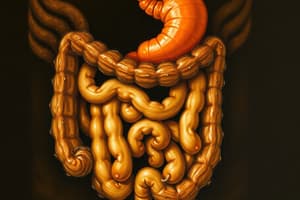Podcast
Questions and Answers
What is the primary role of the digestive system?
What is the primary role of the digestive system?
- To mechanically break down food only
- To break down food into absorbable molecules and facilitate absorption (correct)
- To transport food directly to the bloodstream
- To absorb liquids without processing food
Where does the majority of nutrient absorption occur in the digestive system?
Where does the majority of nutrient absorption occur in the digestive system?
- In the mouth
- In the small intestine (correct)
- In the large intestine
- In the stomach
What initiates the enzymatic digestion of proteins in the digestive system?
What initiates the enzymatic digestion of proteins in the digestive system?
- Brush-border enzymes in the small intestine
- Salivary enzymes in the oral cavity
- Enzymes secreted by the pancreas
- Acid secretion in the stomach (correct)
Which enzyme converts trypsinogen to its active form?
Which enzyme converts trypsinogen to its active form?
What are brush-border enzymes?
What are brush-border enzymes?
What happens to carbohydrate digestion when food reaches the stomach?
What happens to carbohydrate digestion when food reaches the stomach?
Which food molecule is primarily broken down into amino acids?
Which food molecule is primarily broken down into amino acids?
Which of the following statements about pancreatic proenzymes is true?
Which of the following statements about pancreatic proenzymes is true?
What type of enzyme does the pancreas secrete to help in carbohydrate digestion?
What type of enzyme does the pancreas secrete to help in carbohydrate digestion?
Which monosaccharides result from the digestion of carbohydrates by brush-border enzymes?
Which monosaccharides result from the digestion of carbohydrates by brush-border enzymes?
How are triglycerides and long-chain fatty acids processed in the small intestine?
How are triglycerides and long-chain fatty acids processed in the small intestine?
What is the purpose of brush-border digestive enzymes like sucrase, maltase, and lactase?
What is the purpose of brush-border digestive enzymes like sucrase, maltase, and lactase?
What happens to the chylomicrons after they are assembled in the epithelial cells?
What happens to the chylomicrons after they are assembled in the epithelial cells?
How are amino acids absorbed in the small intestine?
How are amino acids absorbed in the small intestine?
Which of the following is NOT a function of lipids in the body?
Which of the following is NOT a function of lipids in the body?
The final absorption of nutrients in the small intestine primarily occurs at which cellular structure?
The final absorption of nutrients in the small intestine primarily occurs at which cellular structure?
Flashcards
Pancreatic amylase
Pancreatic amylase
An enzyme that continues carbohydrate digestion
Brush-border enzymes
Brush-border enzymes
Digestive enzymes on the surface of small intestine cells
Sucrase, Maltase, Lactase
Sucrase, Maltase, Lactase
Brush-border enzymes that digest disaccharides (into monosaccharides)
Monosaccharides absorption
Monosaccharides absorption
Signup and view all the flashcards
Protein digestion products
Protein digestion products
Signup and view all the flashcards
Chylomicron formation
Chylomicron formation
Signup and view all the flashcards
Chylomicron transport
Chylomicron transport
Signup and view all the flashcards
Nutrient fate
Nutrient fate
Signup and view all the flashcards
Digestion in the Oral Cavity
Digestion in the Oral Cavity
Signup and view all the flashcards
Digestion in the Stomach
Digestion in the Stomach
Signup and view all the flashcards
Small Intestine Digestion
Small Intestine Digestion
Signup and view all the flashcards
Pancreatic Proenzymes
Pancreatic Proenzymes
Signup and view all the flashcards
Trypsinogen Activation
Trypsinogen Activation
Signup and view all the flashcards
Trypsin Action
Trypsin Action
Signup and view all the flashcards
Types of ingested food
Types of ingested food
Signup and view all the flashcards
Study Notes
Digestive System Functions
- The digestive system breaks down food into absorbable molecules.
- It absorbs these molecules for use by the body.
- The main food molecules are carbohydrates, proteins, and fats.
Digestion in the Oral Cavity
- Digestion begins in the mouth.
- Food is chewed, and enzymes in saliva start breaking down carbohydrates and fats.
- The food is swallowed, passing to the esophagus.
Stomach Digestion
- Stomach acid denatures enzymes that began digesting carbohydrates.
- Protein digestion begins in the stomach.
- Fat digestion continues.
Digestion in the Small Intestine
- Most digestion and absorption of nutrients occur in the small intestine.
- Enzymes from the pancreas are crucial for this process.
- Many pancreatic enzymes are initially inactive (proenzymes).
- Proenzymes are activated in the small intestine.
- An example of a pancreatic proenzyme is trypsinogen, which becomes trypsin.
- This conversion is catalyzed by enteropeptidase, an enzyme attached to the cell membrane of small intestine epithelial cells.
- Brush-border enzymes (on the surface of the epithelial cells) carry out further digestion of carbohydrates, proteins, and fats. Examples are sucrase, maltase, lactase.
- Carbohydrate digestion products (monosaccharides) are absorbed into the bloodstream.
- Protein digestion products (amino acids) are absorbed into the blood.
- The absorbed triglycerides combine with cholesterol and proteins to form chylomicrons.
- Chylomicrons are absorbed into lymph vessels (lacteals).
- Chylomicrons enter the venous circulation through the thoracic ducts.
Further processing
- The absorbed cholesterol is also transported in the intestines and is processed in cells
Studying That Suits You
Use AI to generate personalized quizzes and flashcards to suit your learning preferences.




